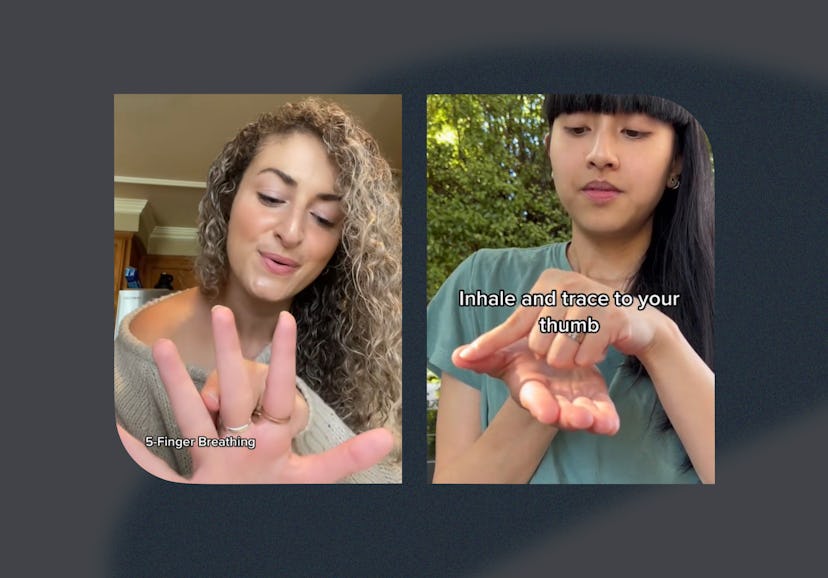Wellness
The Viral “5-Finger Breathing” Technique Will Calm You In An Instant
It’s an expert-approved grounding practice.

For some people, deep breathing exercises work like a charm. For others, not so much. If you fall into the latter category, you might enjoy the “five-finger breathing” technique, which adds a little something extra into the mix.
On TikTok, creators are sharing their love for five-finger breathing, including user @mindfullymadetherapy, who said, “Sometimes just breathing isn’t enough, and you need a coping skill that’s multi-sensory [or] involving other senses to help distract or calm down the brain.”
That’s what sets this technique apart: It isn’t just about closing your eyes and slowly inhaling and exhaling. It also includes a mini grounding technique. As you breathe in and out, you’re supposed to trace the outline of your open hand, breathing in as you trace up the side of one finger, and out as you trace down the other.
In @mindfullymadetherapy’s comments, someone said, “Thank you for this! This helped so much better than just regularly breathing.” Another wrote, “It made all the horrible overthinking stop. Tysm!” Here’s exactly why it works, as well as how to try it.
What Is Five-Finger Breathing?
According to Chloë Bean, LMFT, a somatic trauma therapist in Los Angeles, CA, the five-finger technique is a grounding exercise that combines mindful breathing with gentle touch and movement. As you trace your hand and breathe, “it brings together the two anchors your nervous system trusts most: steady breath and physical contact,” she tells Bustle.
Instead of simply counting inhales and exhales, you anchor your body in the moment by touching your hands, tracing your fingers, and focusing on those sensations — instead of your racing thoughts. “The tactile sensation of tracing helps you to stay present in your senses while the steady rhythm of breathing activates the vagus nerve, which helps the body move from fight or flight to rest and digest.”
It’s a way to perfectly time your inhales and exhales, all without needing to open a deep breathing app on your phone. By slowing your breath, you might be able to calm your anxiety or relieve your overwhelm.
“You are showing your body, ‘I am here, I am listening, we are safe,’” Bean says. “That self-connection, practiced regularly, [can also help] to build capacity for discomfort over time, so you move from stress to calm more quickly and easily — much like strengthening a muscle.”
How To Do “Five-Finger Breathing”
The five-finger technique is helpful whenever you’re anxious, overthinking or simply when you need a reminder to slow down and stay present. “It’s also great before public speaking, after a stressful interaction, or even for winding down to sleep,” Bean says. “You can use it as-needed throughout the day to reset your system.” Here, she explains how to do it.
- Start by holding one hand out with fingers relaxed but spread.
- Inhale through your nose as you slowly trace up the outside of your thumb, using your opposite pointer finger.
- Exhale slowly through your mouth as you slowly trace down the inside of your thumb.
- Continue this rhythm for each finger, next tracing up your pointed finger, then your middle, etc.
- Keep your eyes open.
- Pay attention to the sensation on your hand.
- Softly focus on how your breath is attuned to the movement — and vice versa.
- By the time you reach your pinky, you've done five slow, intentional, full breaths.
Source:
Chloë Bean, LMFT, somatic trauma therapist